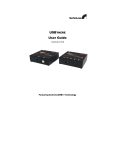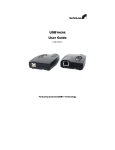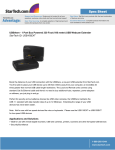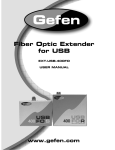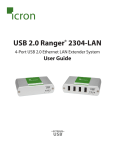Download User Guide - StarTech.com
Transcript
USBTHERE User Guide USB201EXT USB204EXT USB204EXT shown Featuring ExtremeUSB® Technology USBthere USB201EXT/USB204EXT FCC Radio Frequency Interference Statement Warning The USBthere has been tested and found compliant with the limits for a Class A digital device, pursuant to Part 15 of the FCC Rules. These limits are designed to provide reasonable protection against harmful interference when installed and operated in a commercial environment. The USBthere generates, uses, and can radiate radio frequency energy and, if not installed and used in accordance with this user guide, may cause harmful interference to radio communications. Operation of the USBthere in a residential area is likely to cause harmful interference in which case the user will be required to correct the interference at his own expense. CE Statement We, StarTech.com, declare under our sole responsibility that the USBthere, to which this declaration relates, is in conformity with European Standard EN 55022/A1 Class A, and EN 50082-1 (IEC 801-2, IEC 801-3, IEC 801-4) IC Statement This Class A digital apparatus complies with Canadian ICES-003. User Guide Contents Introduction................................................................................................ 1 USBthere Product Contents ....................................................................... 1 About the USBthere ................................................................................... 2 Before You Begin ...................................................................................... 6 Installing the Local Unit ............................................................................ 6 Installing the Remote Unit ......................................................................... 6 Connecting the Local Unit to the Remote Unit.......................................... 7 Checking the Installation............................................................................ 7 Connecting a USB Device ......................................................................... 8 Troubleshooting ......................................................................................... 9 Specifications........................................................................................... 12 Technical Support .................................................................................... 13 Warranty Information .............................................................................. 13 i USBthere USB201EXT/USB204EXT Notes ii User Guide Introduction This manual is intended to assist IT professionals install the USBthere models USB201EXT and USB204EXT. The instructions in this guide assume a general knowledge of computer installation procedures, familiarity with cabling requirements, and some understanding of USB devices. NOTE: Notes give additional information that could make installation easier. USBthere Product Contents When you open your USBthere for the first time you should find the following items: • • • • • USBthere User Guide Local Unit Remote Unit AC power adapter (optional) USB cable (2m long) To complete the installation, you will also require the following items that are not included with the product: • USB compatible computer • USB device • Category 5 Unshielded Twisted Pair (UTP) cable with two RJ45 connectors (if using surface cabling), OR, Category 5 UTP cabling with two information outlets and two Category 5 UTP patch cords with RJ45 connectors (if using premise cabling) NOTE: The maximum length of the Category 5 UTP cable, including patch cords, must not exceed 100m. 1 USBthere USB201EXT/USB204EXT About the USBthere The USBthere incorporates ExtremeUSB® technology. This technology breaks the five-meter distance barrier for the connection of USB peripheral devices and allows users to enjoy the benefits of USB technology beyond the desktop. With the USBthere, USB devices can be located up to 100 meters from the host computer. In addition, the USBthere USB201EXT and USB204EXT can supply power to remote low-power or high-power USB devices. The USBthere is composed of two individual units, the Local Unit and the Remote Unit. The Local Unit The Local Unit connects to the host computer using a conventional USB cable. Depending on your needs, it also connects to a power outlet through an AC power adapter. Front View 3 1 5 6 2 1 Host LED 2 Host Port (USB Type B) 3 Link LED NOTE: 2 4 4 Link Port (RJ45) 5 Power LED 6 Power connector The power adapter for the USBthere USB201EXT can be connected to either the Local Unit or to the Remote Unit, as convenient. With the USBthere USB204EXT, the location of the power adapter also depends on whether you are connecting highpower or low-power USB devices. (See Power Handling on page 4). User Guide The Remote Unit The Remote Unit connects to the USB device using a conventional USB cable. Depending on your needs, it also connects to a power outlet through an AC power adapter. The Remote Unit of the USB201EXT lets you connect one USB device. The Remote Unit of the USB204EXT lets you connect up to four USB devices. Front View Rear View (Remote Unit of USB204EXT) 5 1 3 4 2 6 5 Device LED(s) 6 Device Port(s) (USB Type A) 1 Link LED 2 Link Port (RJ45) 3 Power LED 4 Power connector Network Cabling The Local Unit and Remote Unit are interconnected by up to 100 meters of Category 5 Unshielded Twisted Pair (UTP) cabling. The UTP cabling must have a straight-through conductor configuration, with no crossovers, and must be terminated with 8-conductor RJ45 connectors at both ends. Local USB Remote Category 5 cable cable USB cable(s) Computer USB device(s) AC power adapter (shown connected to Local) NOTE: Category 5 UTP cabling is the standard data communications cable installed in most commercial and some residential buildings. 3 USBthere USB201EXT/USB204EXT USB Cables USB cables have two distinct connectors. The Type A connector is used to connect the cable from a USB device to the Type A port on a computer or hub. The Type B connector is used to attach the USB cable to a USB device. USB Type A port USB Type A connector USB Type B port USB Type B connector Power Handling Some USB devices are powered directly from the USB and do not require individual power supplies. These devices are called bus-powered devices. The USBthere can provide power to these devices so they can be operated remotely. Bus-powered devices are further divided into low-power and high-power categories. Low-power devices are allowed to draw up to 100 mA from the USB. Typical examples include mice, joysticks, and keyboards without hubs. High-power devices are allowed to draw up to 500 mA from the USB. Typical examples include cameras and keyboards with hubs. To determine if a device is high-power or low-power, consult the user documentation for the device. The USBthere USB201EXT and USB204EXT can supply power to both low-power and high-power devices when configured as follows: USB201EXT • To operate any USB device, connect the power adapter to the Local Unit or to the Remote Unit, as convenient. USB204EXT • To operate up to four low-power devices, connect the power adapter to the Local Unit or to the Remote Unit, as convenient. • To operate up to four high-power devices, connect the power adapter to the Remote Unit. NOTE: 4 Devices with their own power source are usually considered to be low-power devices from a USB perspective. User Guide Compatibility The USBthere complies with USB 1.1 specifications governing the design of full speed USB devices. However, StarTech.com does not guarantee that all full speed USB devices are compatible with the USBthere USB201EXT and USB204EXT. 5 USBthere USB201EXT/USB204EXT Before You Begin Before you can install the USBthere, you need to prepare your site. 1. Determine where the host computer is to be located and set up the computer. 2. Determine where you want to locate the USB device(s). 3. Decide whether the power adapter is to be connected to the Local Unit or the Remote Unit. 4. If you are using surface cabling, ensure you have enough Category 5 UTP cabling to connect the two locations. OR If you are using premise cabling, ensure Category 5 UTP cabling is installed between the two locations, with Category 5 information outlets located near both the computer and the USB device. Installing the Local Unit 1. 2. 3. 4. Place the Local Unit near the host computer. If the power adapter is to be located with the Local Unit: a) Plug the power adapter into a suitable AC outlet. b) Connect the power adapter to the Local Unit. Plug the Type B connector on the USB cable (included) into the Host port on the Local Unit. Plug the Type A connector on the USB cable into the USB port on the computer. Installing the Remote Unit 1. 2. 6 Place the Remote Unit near the USB device. If the power adapter is to be located with the Remote Unit: a) Plug the power adapter into a suitable AC outlet. b) Connect the power adapter to the Remote Unit. User Guide Connecting the Local Unit to the Remote Unit NOTE: To ensure proper operation, we recommend that only Category 5 or better, Unshielded Twisted Pair (UTP) cabling be used to connect the Local Unit to the Remote Unit. The UTP cabling must have a straight-through conductor configuration with no crossovers, and must be terminated with 8-conductor RJ45 connectors at both ends. With Surface Cabling 1. Plug one end of the Category 5 UTP cabling (not included) into the Link port on the Local Unit. 2. Plug the other end of the Category 5 UTP cabling into the Link port on the Remote Unit. With Premise Cabling 1. Plug one end of a Category 5 patch cord (not included) into the Link port on the Local Unit. 2. Plug the other end of the patch cord into the Category 5 information outlet near the host computer. 3. Plug one end of the second Category 5 patch cord (not included) into the Link port on the Remote Unit. 4. Plug the other end of the second patch cord into the Category 5 information outlet near the USB device. NOTE: The maximum length of the Category 5 UTP cable, including patch cords, must not exceed 100 meters. Checking the Installation 1. Check that the Power LEDs on the Local Unit and Remote Unit units are both on. 2. Check that the Link LEDs on the Local Unit and Remote Unit units are both on. 3. Check that the Host LED on the Local Unit is on. 4. On the host PC, open the Device Manager applet. Expand the entry for Universal Serial Bus controllers by clicking the + sign. If the USBthere has been installed correctly you should find it listed as a Generic USB Hub. 7 USBthere USB201EXT/USB204EXT Connecting a USB Device 1. 2. 3. 8 Install any software required to operate the USB device(s). Refer to the documentation for the device(s), as required. Connect the USB device to the Device port on the Remote Unit. Check that the Device LED on the Remote Unit is on. User Guide Troubleshooting The following table provides troubleshooting help. The topics are arranged in the order in which they should be executed in most situations. If you are unable to resolve the problem after following these instructions, please contact StarTech.com technical support for further assistance. Symptoms/Cause All LEDs on the Local Unit and Remote Unit are off. Cause: The USBthere is not receiving power from the adapter Power LED on one unit is on, power LED on other unit is off. Cause: There is no connection between the Local Unit and Remote Unit. Link LEDs on Local Unit and Remote Unit units are off. Cause: There is no connection between the Local Unit and Remote Unit. Remedy 1. Ensure that the power adapter is connected to the Local Unit or Remote Unit. 2. Check that the adapter is connected to a live source of electrical power 1. Ensure that a Category 5 UTP cable with straight-through conductors is connected between the Local Unit and Remote Unit. 2. Connect a short Category 5 patch cord between the Local Unit and Remote Unit. Recheck the operation of the system. 1. Ensure that a Category 5 UTP cable with straight-through conductors is connected between the Local Unit and Remote Unit. 2. Connect a short Category 5 patch cord between the Local Unit and Remote Unit. Recheck the operation of the system. 9 USBthere USB201EXT/USB204EXT Symptoms/Cause Remedy USB Hub Power Exceeded message is displayed by the computer. Cause: The USB device connected to the Remote Unit is a highpower device and the power adapter is connected to the Local Unit. 1. Move the power adapter from the Local Unit to the Remote Unit. Link LED on the Local Unit is on; Host LED on the Local Unit is off. Cause: a) The computer is not functioning. b) The Local Unit is not connected to the computer. c) The computer does not support USB hubs. d) The USBthere is malfunctioning. 1. Disconnect all USB devices from the Remote Unit. 2. Disconnect the Local Unit from the computer. 3. Disconnect and then reconnect the power adapter to the USBthere. 4. Reconnect the Local Unit to the computer. 5. In the Universal Serial Bus controllers section of Device Manager, check that the USBthere is recognised as a “Generic USB Hub”. 6. If the USBthere is not recognised, contact StarTech.com technical support for assistance. 10 User Guide Symptoms/Cause Remedy A device is connected to the Remote Unit and the corresponding Device LED is off Cause: a) The USB device is malfunctioning. b) The computer does not recognise the USB device. c) The application software for the device is not operating. d) The USBthere is malfunctioning. 1. Disconnect the USBthere from the computer. 2. Connect the USB device directly to the USB port on the computer. 3. If the device does not operate properly, consult the user documentation for the device. 4. If the device operates properly when directly connected to the computer, connect another device (of a different type) to the USBthere. Connect the USBthere to the computer. 5. If the second device does not operate, the USBthere may be malfunctioning. Contact StarTech.com technical support for assistance. 6. If the second device does operate properly, the first device may not be compatible with the USBthere. Contact StarTech.com technical support for assistance. All LEDs on both Local Unit and Remote Unit are on but the device does not operate correctly Cause: a) The USB device is malfunctioning. b) The computer does not recognise the USB device. c) The application software for the device is not operating. d) The USBthere is malfunctioning. 1. Disconnect the USBthere from the computer. 2. Connect the USB device directly to the USB port on the computer. 3. If the device does not operate properly, consult the user documentation for the device. 4. If the device operates properly when directly connected to the computer, connect another device (of a different type) to the USBthere. Connect the USBthere to the computer. 5. If the second device does not operate, the USBthere may be malfunctioning. Contact StarTech.com technical support for assistance. 6. If the second device does operate properly, the first device may not be compatible with the USBthere. Contact StarTech.com technical support for assistance. 11 USBthere USB201EXT/USB204EXT Specifications Range (over Category 5 UTP cable) 100 meters (330 ft) USB device support Full speed devices (12 Mb/s) Low speed devices (1.5 Mb/s) USB hub support Any single chain can include four USB hubs and one USBthere USB201EXT/USB204EXT, in any order. Power available to USB 1 x 500 mA device at Remote Unit (USB201EXT) Power available to USB 4 x 100 mA (when powered at the Local Unit) device at Remote Unit 4 x 500 mA (when powered at the Remote Unit) (USB204EXT) USB cable 2 meters (6.6 ft) Local Unit connector (upstream) 1 x USB Type B Local Unit connector (downstream) 1 x RJ-45 Remote Unit connector (upstream) 1 x RJ-45 Remote Unit connector (downstream) 1 x USB Type A (USBthere USB201EXT) 4 x USB Type A (USBthere USB204EXT) Local Unit dimensions 107 mm x 84 mm x 34 mm 4.25” x 3.4” x 1.4” Local Unit weight 0.3 kg (0.6 lb) Remote Unit dimensions 107 mm x 84 mm x 34 mm 4.25” x 3.4” x 1.4” Remote Unit weight 0.3 kg (0.6 lb) Total system shipping weight 1.1 kg (2.4 lb) Temperature range 4°C to 40°C Regulatory testing FCC, CE Class A 12 User Guide Technical Support The following technical resources are available for this StarTech.com product: On-line help: We are constantly adding new information to the Tech Support section of our web site. To access this page, click the Tech Support link on our homepage, www.startech.com. In the tech support section there are a number of options that can provide assistance with this product. Knowledge Base - This tool allows you to search for answers to common issues using key words that describe the product and your issue. FAQ - This tool provides quick answers to the top questions asked by our customers. Downloads - This selection takes you to our driver download page where you can find the latest drivers for this product. Call StarTech.com tech support for help: USA/Canada: 1-519-455-4931 UK/Ireland/Europe: 00-800-7827-8324 Support hours: Monday to Friday 9:00AM to 5:00PM EST (except holidays) Warranty Information This product is backed by a one-year warranty. In addition, StarTech.com warrants its products against defects in materials and workmanship for the periods noted below, following the initial date of purchase. During this period, the products may be returned for repair, or replacement with equivalent products at our discretion. The warranty covers parts and labor costs only. StarTech.com does not warrant its products from defects or damages arising from misuse, abuse, alteration, or normal wear and tear. Limitation of Liability In no event shall the liability to StarTech.com Ltd. (or its officers, directors, employees or agents) for any damages (whether direct or indirect, special, punitive incidental, consequential, or otherwise), loss of profits, loss of business, or any pecuniary loss, arising out of related to the use of the product exceed the actual price paid for the product. Some states do not allow the exclusion or limitation of incidental or consequential damages. If such laws apply, the limitations or exclusions contained in this statement may not apply to you. 13 USBthere USB201EXT/USB204EXT Notes 14 User Guide Notes 15 -




















